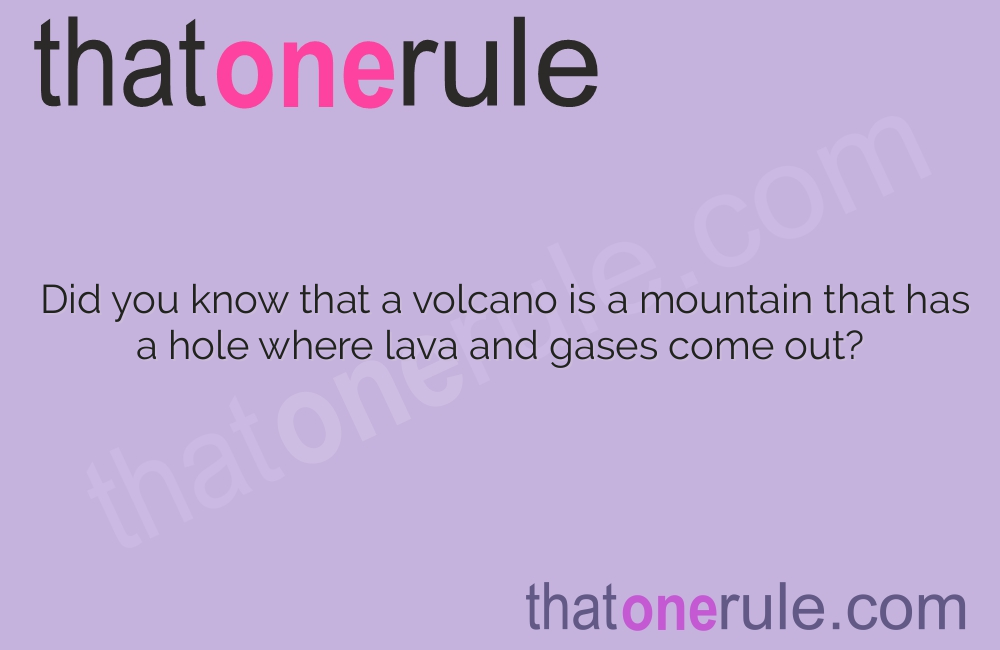

Did you know that a volcano is a mountain that has a hole where lava and gases come out?
Did you know that a volcano is a mountain that has a hole where lava and gases come out?
Volcanoes can be found on land and underwater!
The Earth’s largest volcano is called Mauna Loa and it’s located in Hawaii.
Some volcanoes are so tall that they even reach the clouds!
Lava from volcanoes can travel at speeds of up to 40 miles per hour.
Volcanoes can create new land by adding layers of lava and ash.
The word volcano comes from the Roman god of fire, Vulcan.
Hot magma inside a volcano can reach temperatures of over 1,000 degrees Celsius.
Did you know that dormant volcanoes can become active again after many years?
The eruption of Mount Vesuvius in 79 AD buried the city of Pompeii under ash and preserved it for thousands of years.
Some volcanoes have craters that can be several miles wide.
Volcanic ash can travel long distances, covering entire cities and even affecting air travel.
Did you know that the moon has volcanoes too?
The ash, gases, and rocks from a volcanic eruption are collectively called tephra.
People who study volcanoes are called volcanologists.
The tallest active volcano in Europe is Mount Etna, located in Sicily, Italy.
Volcanic eruptions can create thunderstorms and even produce lightning.
The most famous volcano in the United States is Mount St. Helens in Washington State.
Did you know that there are underwater volcanoes called submarine volcanoes?
Volcanoes can have different shapes, such as a shield, cinder cone, or stratovolcano.
The volcanic eruption of Tambora in 1815 caused a global temperature drop, resulting in a year without summer.
Some volcanic explosions are so powerful that they can be heard hundreds of miles away.
The lava that flows out of a volcano can be as thin as water or as thick as toothpaste.
Did you know that the Hawaiian Islands are the result of volcanic activity?
Volcanic gases can include sulfur dioxide, carbon dioxide, and even poisonous gases like hydrogen sulfide.
The deepest volcano in the world is the Kavachi volcano, located in the Solomon Islands.
The eruption of Mount Pinatubo in 1991 in the Philippines was one of the largest of the 20th century.
Volcanic soil is very fertile and great for agriculture.
The Ring of Fire is a region in the Pacific Ocean where many volcanic eruptions and earthquakes occur.
Some volcanoes have been extinct for millions of years, meaning they will never erupt again.
The Greek island of Santorini was formed by a massive volcanic explosion that created a ring-shaped caldera.
Volcanic eruptions can create pyroclastic flows, which are a fast-moving mixture of hot gas, ash, and rocks.
The volcanic rock called obsidian was used by ancient civilizations to make sharp tools and weapons.
Volcanic activity can also create geysers and hot springs, like those in Yellowstone National Park.
The eruption of Mount Krakatoa in 1883 caused a series of massive tsunamis that killed thousands of people.
Volcanic activity can sometimes trigger earthquakes in nearby areas.
Volcanic ash can be harmful to plants, animals, and humans, as it can cause respiratory problems.
The eruption of Mount Tambora in 1815 had a global cooling effect, resulting in crop failures and widespread famine.
Iceland is known for its many active volcanoes, including Eyjafjallajökull that erupted in 2010 and disrupted air travel across Europe.
The sound of a volcanic eruption can be as loud as a jet airplane taking off.
Volcanoes can change the landscape by creating new mountains, valleys, and even lakes.
The eruption of Mount Pelee on the island of Martinique in 1902 destroyed the city of Saint-Pierre and killed almost 30,000 people.
Did you know that the Earth’s moon has the largest volcanic eruption in our solar system? It’s called the Moon’s Ocean of Storms.
Volcanic eruptions can release large amounts of ash into the atmosphere, blocking the sunlight and causing temporary cooling.
Volcanoes have fascinated people for centuries and continue to inspire awe and curiosity.
Around the world, coffee enthusiasts enjoy Monin coffee concentrate since it is a multipurpose product. Conveniently combining…
The Importance of Choosing the Right Shower for Your Bathroom Renovating your bathroom can be…
Usain Bolt holds the record for the fastest 100-meter sprint in history.Bolt was named Sportsman…
Love is in the air... and it smells suspiciously like chocolate!Roses are red, violets are…
Life's a beach, take a picture and relax.Sun, sand, and salty kisses. That's what beach…
Hungary is home to the largest thermal water cave system in the world.The Rubik's Cube…